The bus route from Hanoi to Sapa
Hanoi to Sapa by bus is a straightforward and comfortable journey, mostly following modern express highways.
Through Hanoi
The bus to Sapa starts by navigating out of Hanoi’s busy streets. Most buses include hotel pick-up from the Old Quarter or depart from a central office before heading to the expressway.
Express Highway to Lao Cai
The longest part of the bus route from Hanoi to Sapa is on the Hanoi–Lao Cai Expressway. This highway is smooth, safe, and fast — no mountain roads, no winding curves. The scenery here isn’t particularly special, but this section cuts the travel time down dramatically.
Last stretch: Mountain road to Sapa
Once the bus exits the expressway near Lao Cai, the final leg climbs the mountain highway to Sapa. This is the most scenic part of the trip — winding roads, rice terraces, valleys, and mountain views as you approach the town of Sapa.
Option 1: Travel by night bus to Sapa
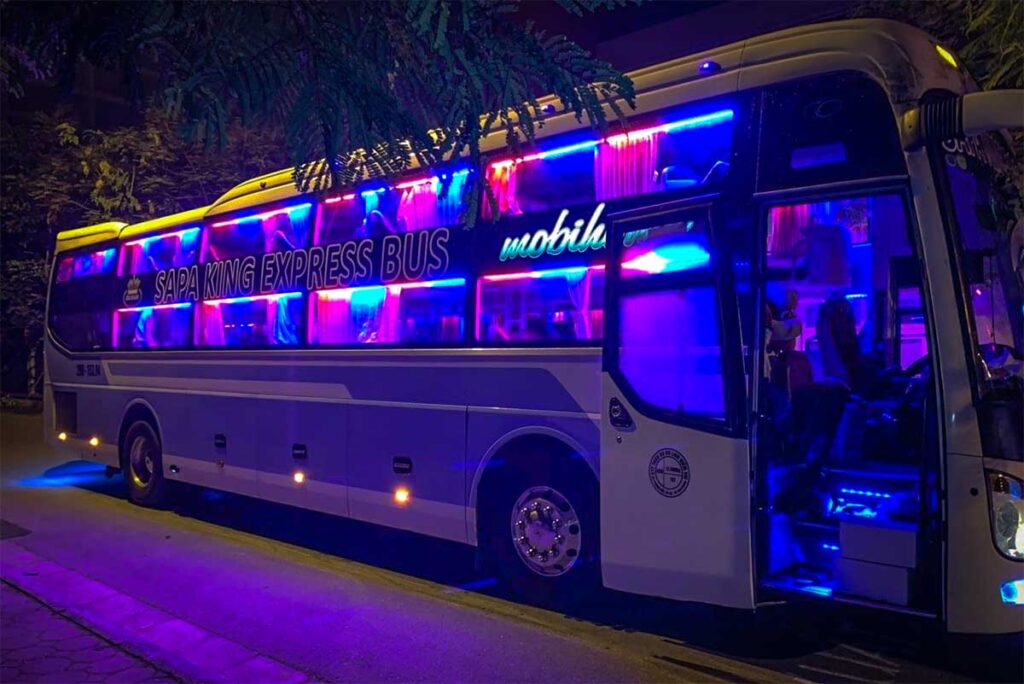
Taking a night bus from Hanoi to Sapa is one of the most popular options, especially for budget travelers and anyone looking to save daytime for exploring. It’s also a way to save on a night of accommodation since your bed is effectively on the bus.
This option is very common among backpackers, solo travelers, and younger travelers, but also works for anyone comfortable with overnight road travel.
Departure and arrival times
- Departure from Hanoi: Usually between 9:00 PM and 11:00 PM.
- Arrival in Sapa: Between 3:00 AM and 6:00 AM, depending on the bus company and road conditions.
Some night buses are faster than others. Smaller VIP sleeper buses generally make fewer stops and arrive a bit earlier than larger standard sleeper buses.
What to expect on a night bus to Sapa
- Buses are equipped with reclining sleeper seats or flat sleeper beds, depending on the type (we’ll explain bus types later).
- Most buses do not have toilets onboard, but they stop once for a bathroom and snack break midway on the express highway.
- Blankets are provided, but the air conditioning can feel cold — bring a sweater or light jacket.
- If you arrive in Sapa very early (some buses get there as early as 3 AM), most hotels are not open for check-in yet. Some bus companies allow passengers to stay and sleep inside the parked bus until sunrise — but this depends on the company, so ask when booking.
Pros of taking the night bus to Sapa:
- Saves daytime for sightseeing or trekking.
- Can save a night of accommodation costs.
- Direct service — no transfers needed, you arrive right in Sapa town center.
- Multiple bus types to choose from depending on your budget and comfort level.
Cons of the night Bus:
- Not everyone sleeps well on buses, especially if you’re sensitive to motion.
- Arrival times can be inconveniently early, meaning you might have to wait to check in or rest somewhere until morning.
- Mountain roads on the final stretch can be a bit bumpy, especially in the dark.
Is the night bus to Sapa right for You?
Choose this option if you’re looking for convenience, saving daytime hours, or are traveling on a budget. But if you’re a light sleeper, anxious about night driving, or don’t want to arrive in Sapa while it’s still dark, consider the day bus or the train instead.
Option 2: Travel by day bus to Sapa
Taking a day bus from Hanoi to Sapa is the best choice for travelers who prefer not to travel overnight. Whether you simply can’t sleep on moving buses or feel uncomfortable with night travel, daytime buses offer a safer and more relaxing alternative.
This option is becoming increasingly popular with families, couples, and travelers who want to enjoy a full night of proper sleep in a hotel before setting off.
Departure and arrival times
- Departure from Hanoi: Usually between 6:00 AM and 9:00 AM.
- Arrival in Sapa: Typically between 12:00 PM and 3:00 PM, depending on the bus type and any stops along the way.
The fastest buses are the smaller limousine vans, while standard sleeper buses may take a bit longer.
Scenery along the route
- The route from Hanoi to Sapa by bus is not highly scenic for most of the way, as it follows the modern Hanoi–Lao Cai Expressway. You’ll mainly see towns, highways, and countryside fields.
- The final hour, climbing from Lao Cai to Sapa, is by far the most beautiful — with winding mountain roads, terraced hillsides, and sweeping valley views.
If you’re hoping for stunning landscapes the entire way, this bus route won’t provide that — but the convenience outweighs this for most travelers.
What to expect on a day bus to Sapa
- Limousine vans (9–16 seats) are the most comfortable choice for daytime trips, offering wide seats, USB chargers, and fewer passengers.
- Sleeper buses also operate during the day — the same reclining bed-style seats used at night. Some travelers find them more comfortable than standard buses, others prefer sitting up in vans.
- A bathroom stop is included halfway, but most buses do not have toilets onboard.
Pros of taking the day bus to Sapa:
- No night travel stress — feels safer and more relaxed.
- You can enjoy the mountain scenery during the final stretch.
- Arriving in Sapa by bus during the afternoon feels natural for hotel check-in and starting your trip.
- Limousine vans offer a very comfortable experience, almost like a private transfer but at a bus price.
Cons of the Day Bus:
- Takes up most of the day of. You’ll arrive in Sapa in the afternoon, so that day is mostly spent on the road.
- Some travelers dislike the half-reclining beds of sleeper buses during the day — limousine vans are better for this.
- First part of the route isn’t particularly scenic.
Is the day bus to Sapa right for you?
The day bus from Hanoi to Sapa is perfect if you prioritize comfort, safety, and arriving at a normal time. If you don’t mind using up a full day for travel, it’s a stress-free way to get from Hanoi to Sapa by bus without the hassle of overnight journeys.
Different bus options on the route from Hanoi to Sapa
There are several types of buses operating between Hanoi and Sapa, catering to different budgets and comfort levels. Whether you’re looking for the cheapest ride, maximum comfort, or something in between, there’s a bus option for you.
Here’s how the different buses to Sapa compare:
1. Limousine Vans (Day only)
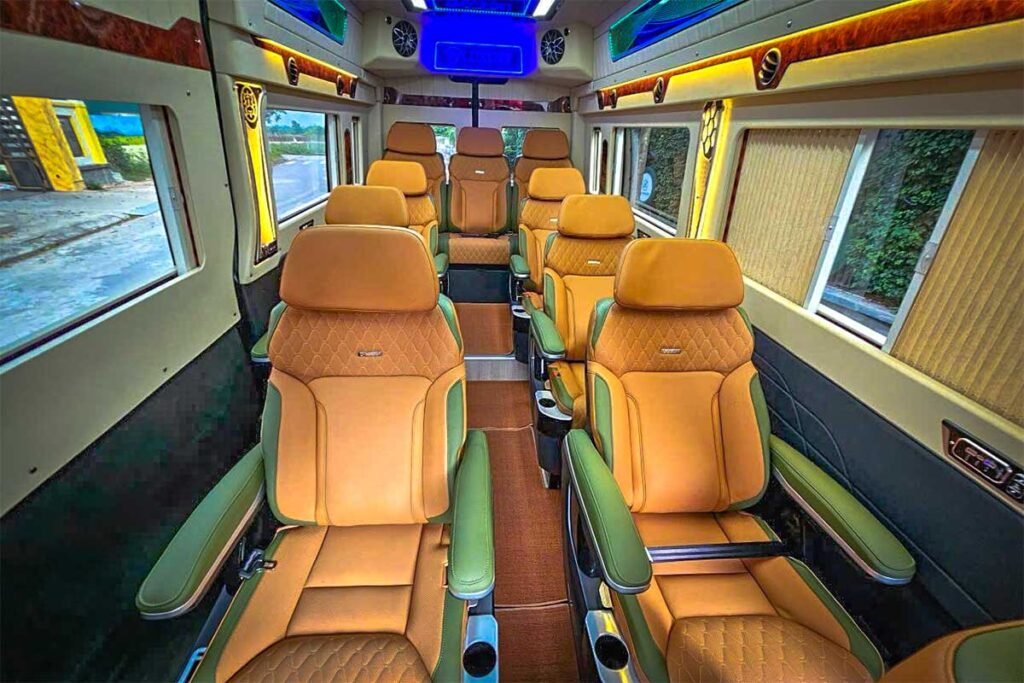
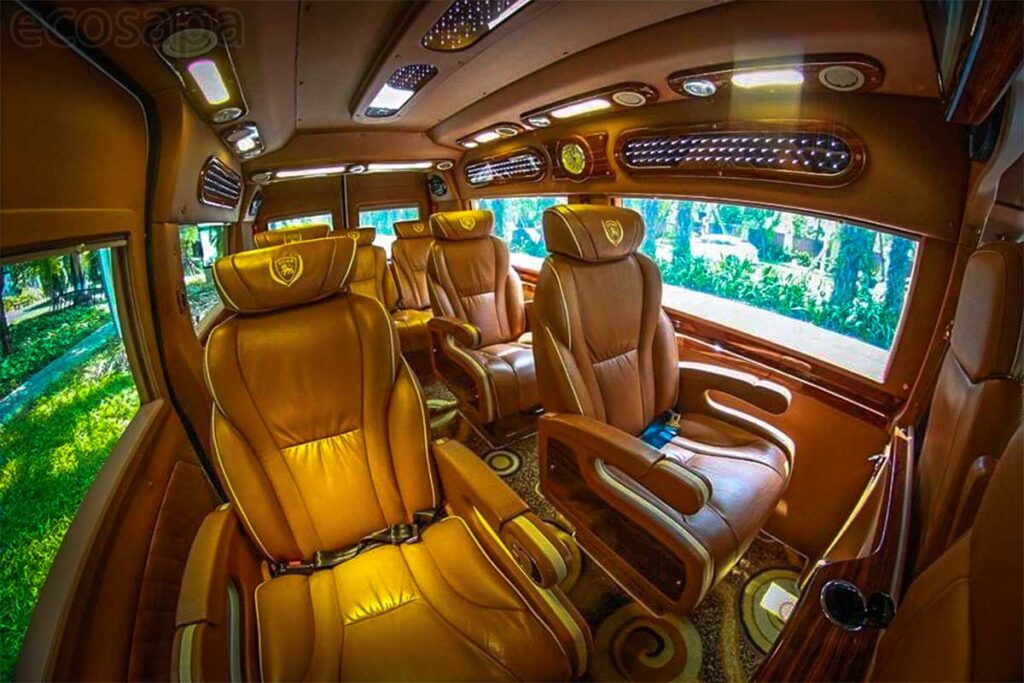
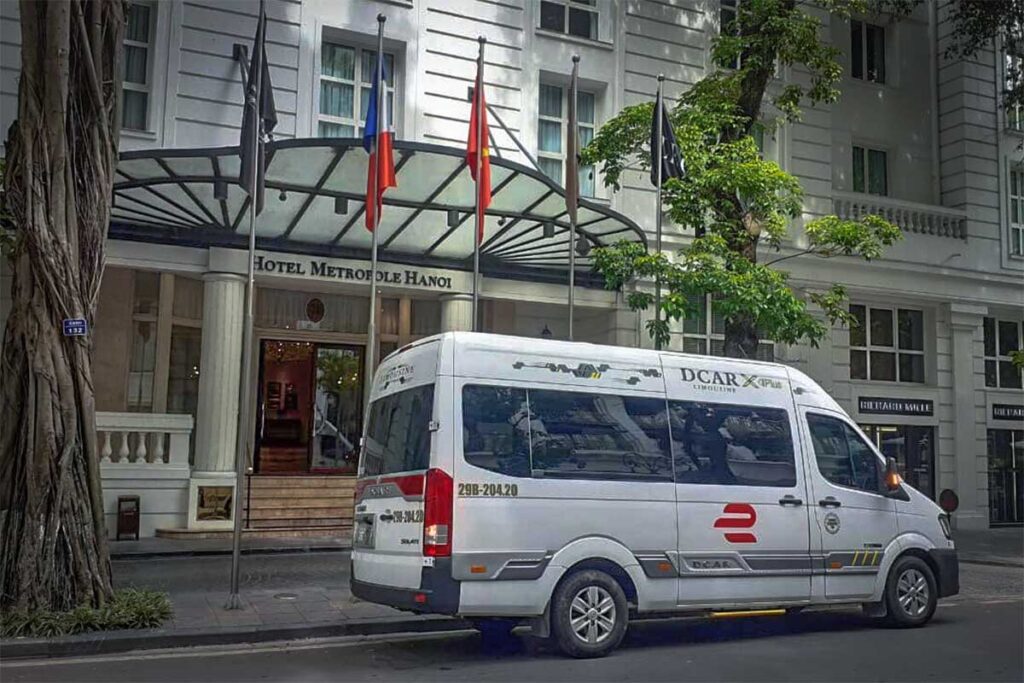
- Description: 9 to 16-seater luxury vans designed for comfort. Wide leather seats, lots of legroom, USB chargers, air-conditioning, and often Wi-Fi onboard.
- Best for: Travelers who dislike sleeper-style buses and prefer upright seats. Ideal for daytime travel.
- Downside: Not available for overnight trips.
- Price: ~$18–22 USD per person.
2. Standard sleeper buses (Day & Night)
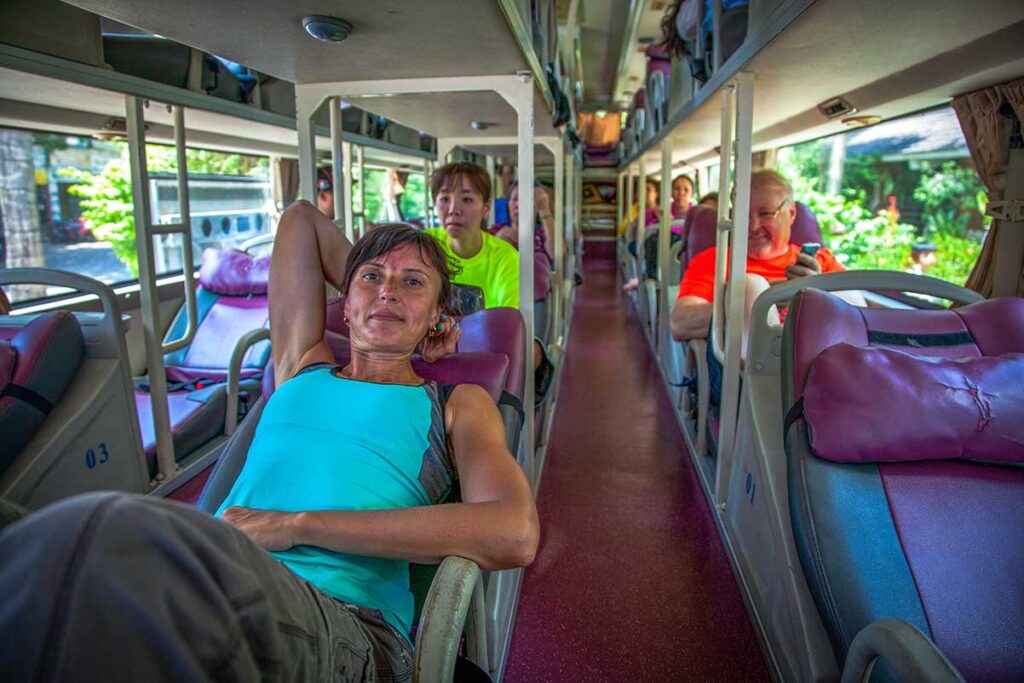
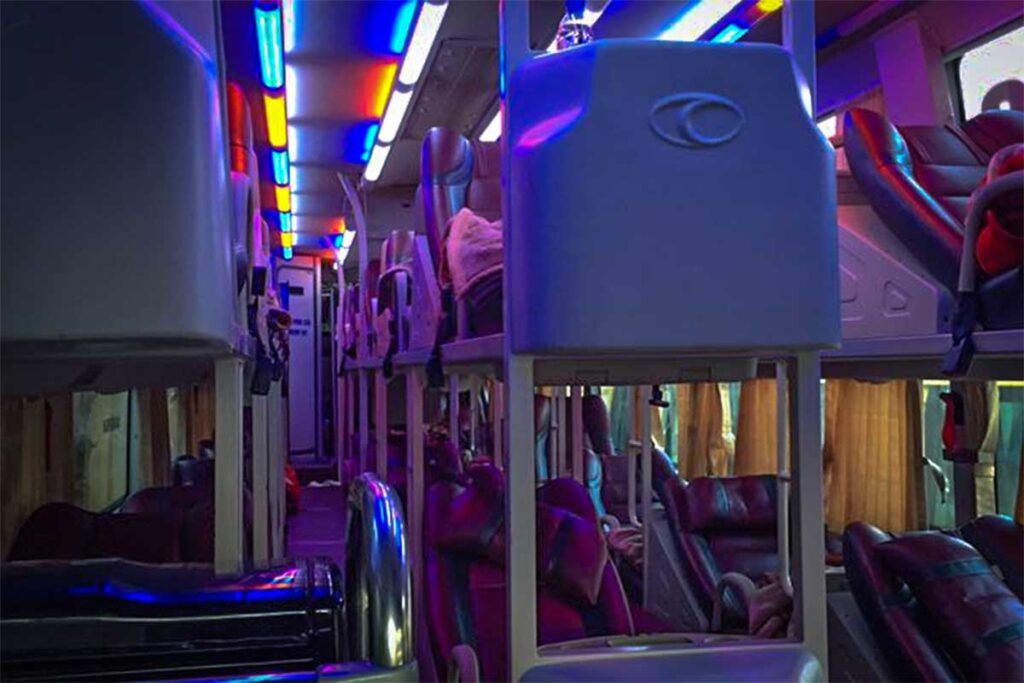
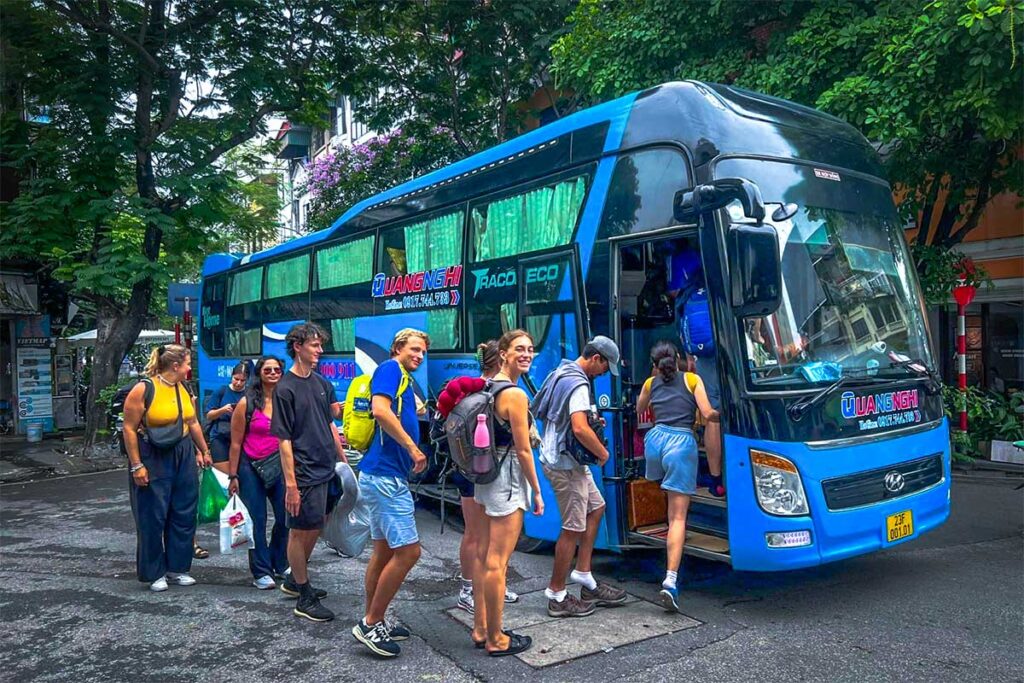
- Description: Classic Vietnamese sleeper buses with bunk-style, fully reclining beds. Functional but basic. No privacy curtains on most standard buses.
- Best for: Budget travelers who don’t mind sharing space with up to 40 passengers in a compact layout. Works for both daytime and night trips.
- Downside: Basic comfort. Limited space if you’re tall. Noisy if the bus is full.
- Price: ~$14–20 USD per person.
3. Limousine Sleeper Buses (Day & Night)
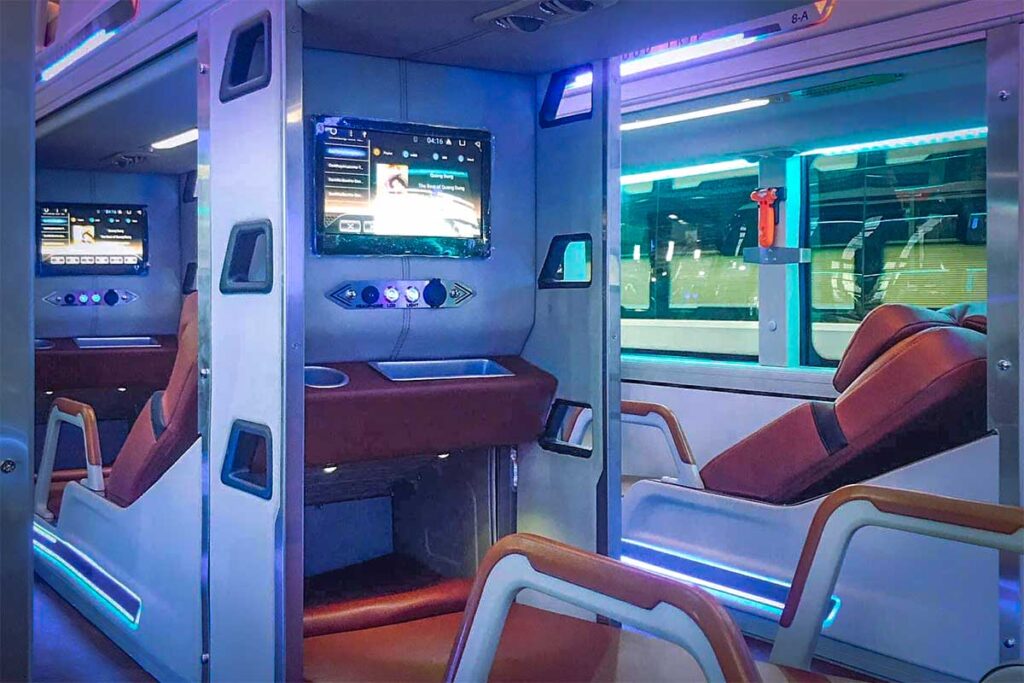
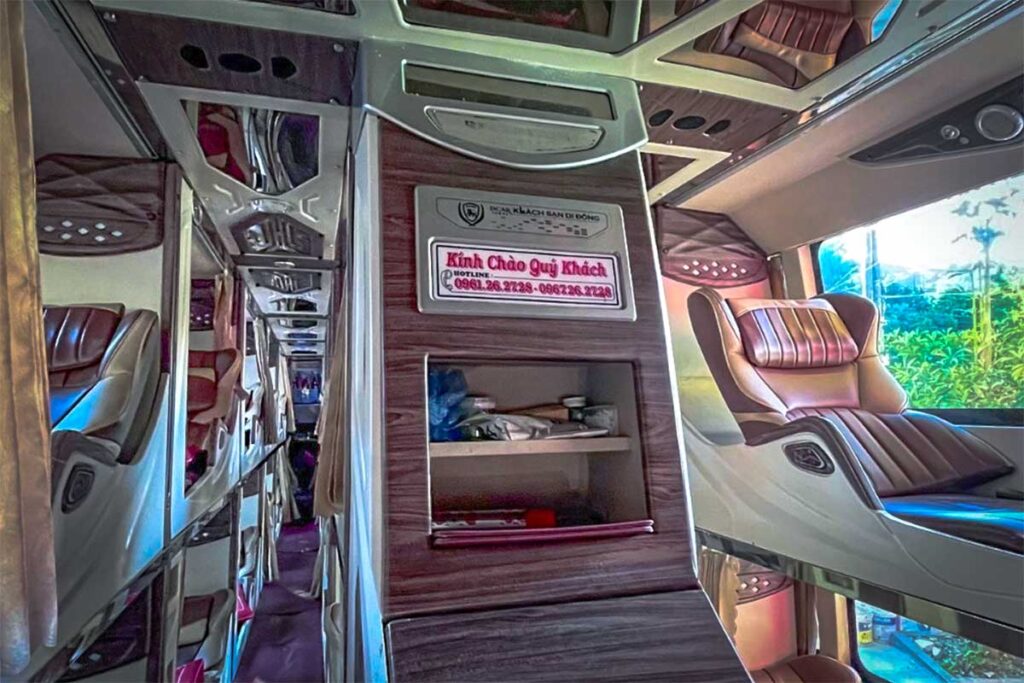
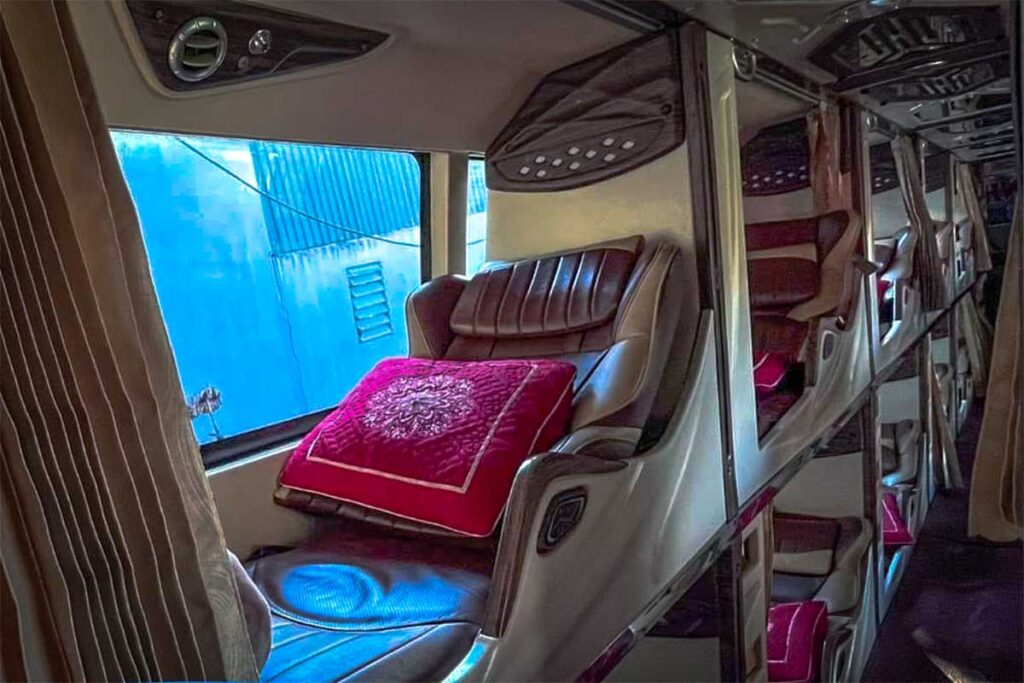
- Description: A step up from the standard sleeper. Fewer beds (around 32 instead of 40), wider reclining pods, privacy curtains, USB charging, and often better AC and facilities.
- Best for: Travelers who want to save money compared to a private car but prefer more comfort and privacy than standard sleepers.
- Downside: Still a shared space, but with better privacy and comfort.
- Price: ~$20–25 USD per person.
4. VIP Cabin Buses (Day & Night)
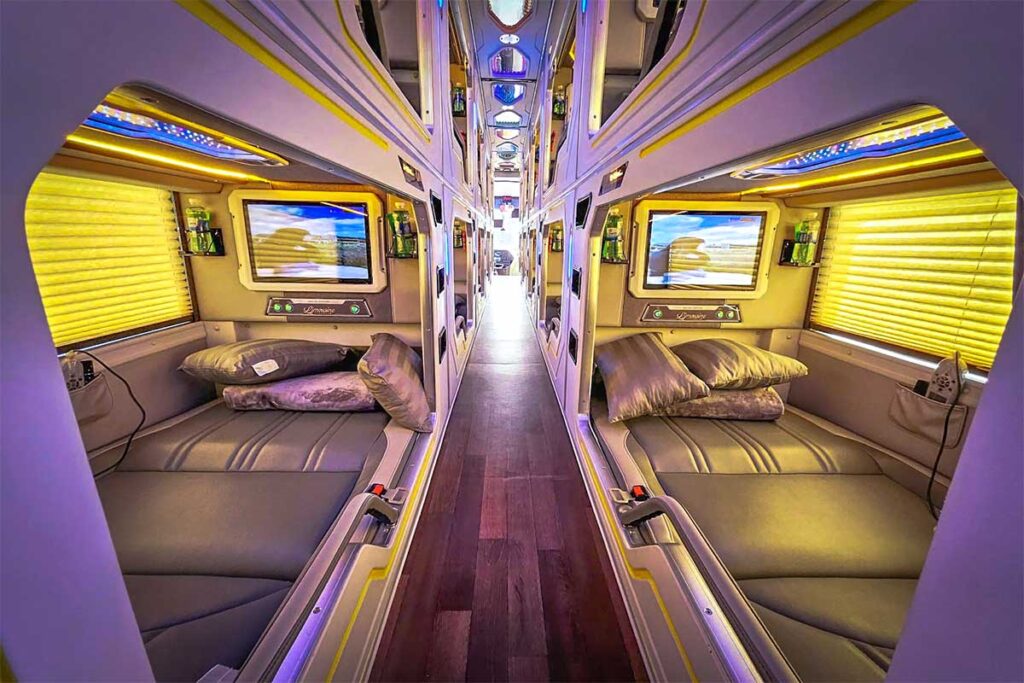
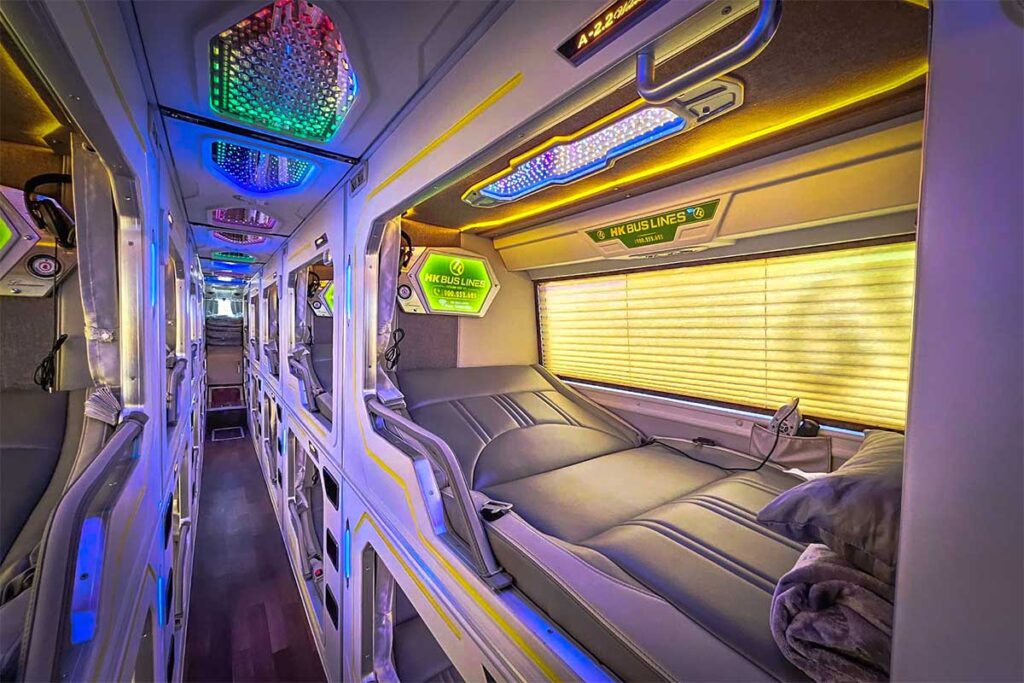
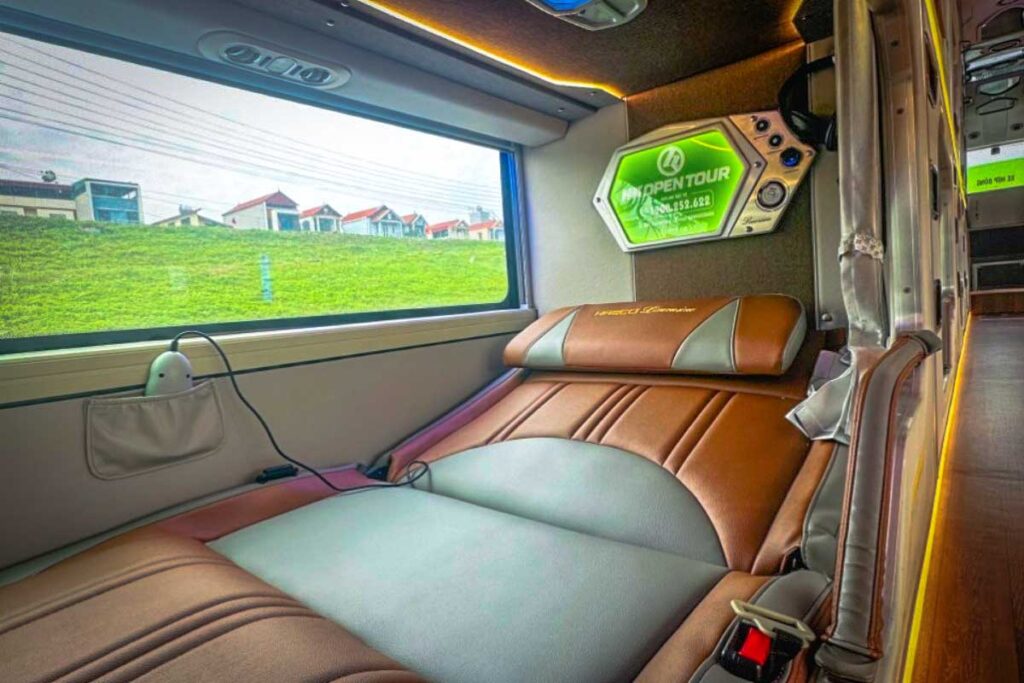
- Description: The most luxurious bus type on the Hanoi to Sapa by bus route. Extra-large sleeping pods, almost flat beds, personal screens on some buses, curtains for full privacy, and top-notch AC.
- Best for: Travelers prioritizing comfort but who don’t want to pay for a private car. Good for both day and night travel.
- Downside: Limited availability — not all companies offer this type.
- Price: ~$25–30 USD per person.
5. Standard Seated Buses (Rare)
- Description: Basic buses with regular upright seats. These are rarely used for long-distance travel like bus to Sapa from Hanoi, but you may see them.
- Best for: Only for those who absolutely dislike sleeper-style buses and can’t get a limousine van.
- Downside: Less comfortable, less legroom, and no beds — not ideal for a 6-hour trip.
- Price: Often similar to limousine vans (~$18–22 USD), which are far more comfortable.
Popular bus companies on the Hanoi to Sapa Route
There are many bus companies offering trips from Hanoi to Sapa by bus, and honestly, they are quite similar. Most use the same types of buses — sleeper buses, limousine sleepers, or daytime vans — and offer comparable prices and service levels.
Some of the bigger and more commonly used companies are:
- G8 Sapa Open Tour
- Sapa Express
- HK Buslines
These companies are generally reliable and focus on serving both tourists and locals traveling between Hanoi and Sapa.
That said, the bus experience in Vietnam can vary — not so much by company, but depending on the driver, traffic, how full the bus is, and the condition of the vehicle that day. This is completely normal for bus travel in Vietnam.
Tip: Don’t stress too much about choosing the “best” company. Focus instead on choosing the bus type (limousine van, VIP sleeper, or standard sleeper) that fits your comfort needs and travel time.
How to book bus tickets from Hanoi to Sapa
Booking a bus to Sapa from Hanoi is easy, with several options depending on your preference for convenience and price.
1. Online booking platforms
The easiest and most popular way for both locals and tourists to book.
- Vexere – The biggest local bus booking site in Vietnam. Great prices and a wide choice of bus companies.
- 12Go Asia – Very user-friendly for tourists. Clear schedules, upfront prices, and good customer service in English.
- Baolau – Similar to 12Go, with real-time availability and the option to compare buses, trains, and flights.
Tip: Online platforms let you compare different bus types like sleeper buses, limousine sleepers, and vans — so you can pick exactly what fits your needs.
2. Travel agents & Hotels in Hanoi
Most hotels in Hanoi’s Old Quarter can book your Hanoi to Sapa bus for you.
Expect a small markup (a few dollars), but the benefit is clear — they handle all the communication with the bus company, confirm your hotel pickup, and assist if anything goes wrong.
This is especially useful if you don’t want to worry about finding the right pickup point yourself.
Tip: Check the prices listed in our bus types section to compare whether your hotel’s price feels reasonable.
Discover our Sapa tours – all trips fully arranged
Check out our Sapa tours that include everything — travel from Hanoi and back, handpicked accommodations, and unforgettable experiences like scenic car drives, trekking through rice fields, and visiting ethnic markets. Everything is organized for you from start to finish.
3. Booking direct with bus companies
- Some bus companies have their own websites, Facebook pages, or WhatsApp numbers for direct bookings.
- However, not all have English-speaking staff, so it can be hit or miss depending on the company.
- Buying tickets directly at the bus station is technically possible — but not recommended. The time and cost of getting to the station won’t save you much, and most buses depart from central pickup locations rather than the main bus terminal anyway.
Tips for traveling to Sapa by Bus
Make your bus to Sapa from Hanoi more comfortable with these practical tips:
- Bring headphones or earplugs: Buses can be noisy — from phone calls to fellow passengers chatting or watching videos without headphones. Block it out if you want to sleep or relax.
- Pack snacks and drinks: The bus provides a small water bottle, but that’s it. There’s usually one rest stop halfway with snacks, but options are limited. Stock up before boarding.
- Plan toilet breaks: Most buses don’t have onboard toilets. Expect one stop halfway for bathroom breaks. Go before departure too, just to be safe.
- Wear something warmer: Air conditioning can get quite chilly, especially on sleeper buses. Plus, if you arrive in Sapa early morning, mountain air can be cold — even in summer.
- Charge your devices fully: Some Hanoi to Sapa buses have USB charging, but not all, and sometimes it doesn’t work. Have a power bank ready if you rely on your phone for music, maps, or entertainment.
- Download offline entertainment: Podcasts, movies, music — Wi-Fi is either unreliable or non-existent on most buses.
- Bring a neck pillow and blanket: Blankets are provided on sleeper buses but often thin. A neck pillow makes a huge difference for daytime limousine vans.
Bus vs Train – What’s better?
Not sure whether to take the bus to Sapa from Hanoi or travel by train? Both options have clear pros and cons, depending on your priorities. If you’re curious about the train in detail, check our full guide: Hanoi to Sapa by Train.
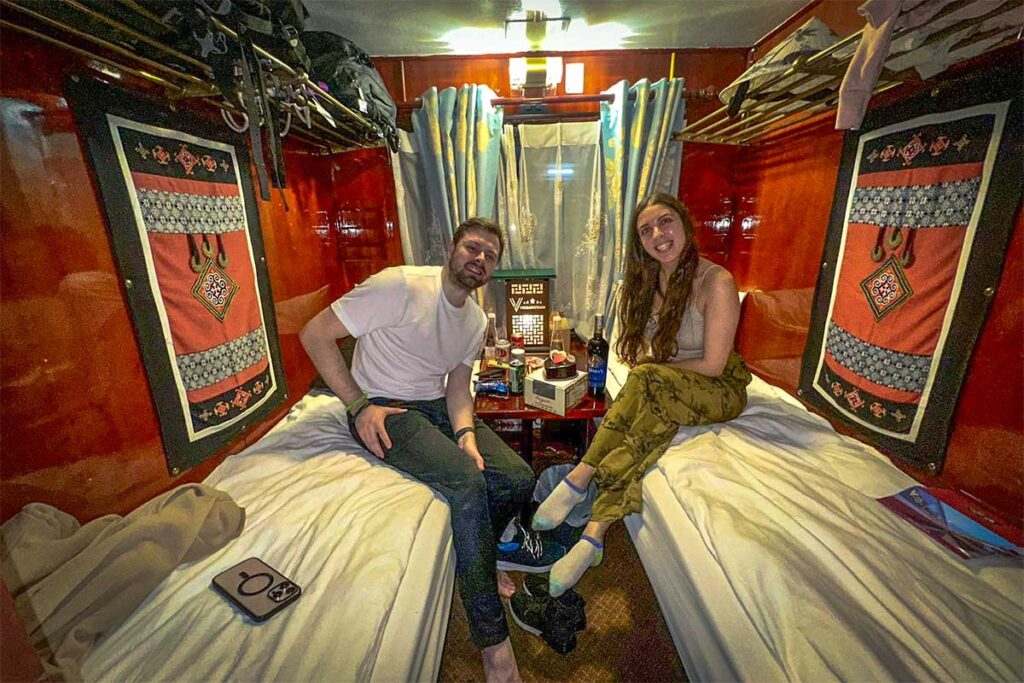
What’s better about taking the train?
- More comfortable for sleeping: Real beds with flat mattresses in private cabins, instead of bunk seats on a bus.
- Feels safer overnight: No highways, no overtaking, no traffic — just the steady rhythm of the train.
- You can move around: Stand up, stretch your legs, visit the toilet anytime.
- A unique travel experience: The Hanoi to Sapa train has a nostalgic charm that feels like part of the adventure, not just transport.
What’s less convenient about the train?
- Slower: The train takes about 8 hours, plus an additional 1-hour transfer from Lao Cai to Sapa.
- More expensive: Especially if you choose one of the tourist trains with higher comfort levels.
- Not direct to Sapa: You’ll need to arrange a shuttle, taxi, or private car from Lao Cai station to reach Sapa town.
- Fewer departure times: Trains are mostly overnight only, while buses offer both day and night options.


